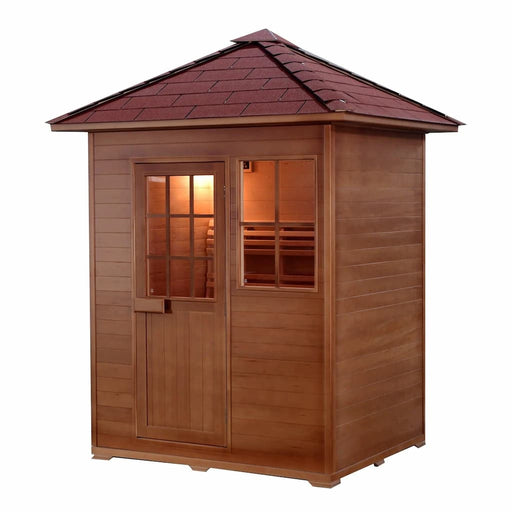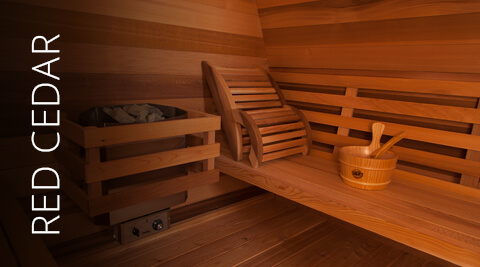The Greatest Guide To Traditional Sauna
The Greatest Guide To Traditional Sauna
Blog Article
The Greatest Guide To Traditional Sauna
Table of ContentsExcitement About Traditional SaunaIndicators on Traditional Sauna You Need To KnowUnknown Facts About Traditional SaunaUnknown Facts About Traditional SaunaThe Buzz on Traditional Sauna
A lot of the weight lost in a sauna is water loss and is re-gained upon rehydrating. Without a question sauna can be a vital component of a healthy weight loss program. To take a look at the distinctions between conventional and IR saunas, I will certainly divide these right into proven, theoretical, and made differences.Therefore, the hottest factor in the saunawhich goes to the ceiling straight above the sauna heateris normally between 185 and 190 F. Claims that a standard sauna exceeds 200 F is merely not real and not appropriate for electric saunas marketed in the US. The temperature for a far-infrared sauna is normally set in between 120 and 140 F; nevertheless, unlike the traditional sauna, the objective in and IR space is not to accomplish a heat.
Since of this, the temperature difference is practically pointless, considering that profuse sweating leads to both sauna types, but the technique of heating the body is different. In an IR sauna the bather will really feel warm and will certainly sweat a lot, yet at a lot reduced temperatures. Traditional Sauna. Hence, if the objective is to spend longer amount of times in the sauna, the IR sauna is a good choice

Get This Report about Traditional Sauna

When the high temperature level is attained, the elements cycle on and off to preserve the heat. Traditional Sauna. A lot of standard sauna customers enjoy pouring water over the rocks to create heavy steam to increase sauna humidity levels. The benefits of putting water over the rocks consist of: making the room a lot more comfy, dampening the nasal flows, and allowing the usage of aromatherapy by blending important oils with the water
In a far-infrared sauna, the warm front permeate the body to effectively heat up the body and increase the body core temperature. To accomplish this enhanced temperature level, Far-infrared emitters develop infrared energy which is close to our website the exact same wavelength as that which the body normally emitsoften described as the "Important Variety" of 7 to 14 microns), so the power is well obtained by the body.
When the power gets in the body, it causes the body temperature to increase and inevitably leads to perspiration. In an infrared sauna it is essential for the emitters/heaters to continue to be on virtually regularly. Because there is no mass of rocks to retain warmth, the sauna will certainly cool if the emitters turned off.
The Facts About Traditional Sauna Revealed
As discussed over, the sauna bather in an infrared room wishes to place himself before running emitters to obtain maximum gain from the heat. The home heating time for both rooms can be very different, relying on how the rooms are made use of. For a conventional sauna, a bather ought to enable 30-40 minutes for the area to attain a wanted temperature and to correctly pre-heat the rocks.
A well constructed sauna will generally accomplish a temperature of 150-160 F in regarding 30-40 mins. For hotter temperature levels, the space might need to warmth for a longer period.

Conventional saunas tend to be bigger (hence utilize more electrical power) than infrared saunas, although traditional saunas are certainly readily available in one and two person sizes. For a two-person standard sauna, 5x6 or 5x7 size is most popular. The top bench can conveniently seat two or 3 individuals and is likewise enough time to exist down throughout the sauna session.
What Does Traditional Sauna Do?
The ordinary price per kWH of electrical power in the united state is roughly $0.11 - Traditional Sauna, so a 4.5 kW heating unit will certainly set you back roughly $.50 to run for one hour, if the heating unit runs constantly for one hour. Commonly a sauna heating unit will certainly compete 75% of the first hour and visit the site 50% of subsequent hours on because the aspects cycle once the established temperature is accomplished
A two person far-infrared space is usually literally smaller sized than a conventional sauna, commonly regarding 4' x 4' or smaller. The IR heating unit is normally 1.5-1.7 kW utilizing a 120 volt 15 amp plug-in service. Since the area can be utilized quicker than a sauna room, we will think the room is utilized for to of an hour consisting of warmth up time.
There is a seldom reviewed difference in the social experience in between the two spaces. While our society has actually lost a my explanation few of the social benefit of the typical sauna experience, it can be very socially gratifying. From family members time in the sauna, to heart-felt discussions with significant others, to sauna partiesthe conventional sauna experience can cause intimate mingling.
Not known Details About Traditional Sauna
Many higher end infrared rooms consist of tinted light therapy, audio systems and full-glass fronts.
Report this page